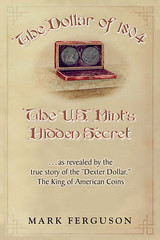
PREV ARTICLE
NEXT ARTICLE
FULL ISSUE
PREV FULL ISSUE
BOOK REVIEW: THE DOLLAR OF 1804
Charles Morgan and Hubert Walker of CoinWeek published a review of Mark Ferguson’s new book on the 1804 Dollar on May 16, 2014. Here's a short excerpt; be sure to read the complete article online.
-Editor
It’s hard reading Mark Ferguson’s book without thinking of Eric P. Newman and Kenneth Bressett’s The Fantastic 1804 Dollar (1962). Not only does every book concerning 1804 dollars have to answer, in some way, to that landmark work, but The Dollar of 1804: The U.S. Mint’s Hidden Secret feels like Ferguson’s direct response to it. Where Fantastic succeeded was in its full-throated challenge to what was then orthodoxy regarding the coin’s origins. Before its publication, the 1804 dollar was a coin steeped in mystery and mythology, made ever murkier by dubious claims, accusations, and self-serving marketing. Newman and Bressett sought to cut through the hype surrounding the “King of American Coins” and assert, once and for all, that the coin was an imposter, by all evidence struck much later than its inscribed date. Every 1804 dollar, according to Newman and Bressett, was in fact, a coin of dubious origins. Every 1804 dollar has a fascinating backstory. Of all of them, the Dexter dollar may be the most misunderstood. Ever since the coin’s first known public offering in a German auction conducted by Adolph Weyl, the Dexter dollar has been the subject of scrutiny, suspicion, and slander. Even Newman and Bressett got their digs in, alleging that its placement in the Weyl catalog was a conspiracy on the part of the Chapman Brothers to conceal its true origin by giving it a phony European pedigree. Coin dealer and Chapman rival Edouard Frossard advanced a similar theory. He filled the pages of his publication Numisma with biting assertions that the coin was a restrike and that the Chapmans were perpetrating a fraud. Frossard looms large in the narrative and his mission to discredit the Chapmans plays a major role in the Dexter story. Ferguson’s book makes pains to enlighten us with actual facts. For too long, the Dexter dollar has been shrouded in intrigue. How Weyl acquired the 1804 dollar remains unknown, Ferguson writes, but surviving correspondence between the Chapmans and Weyl unravel any alleged conspiracy that the two parties were working together to conceal the coin’s original source. Ferguson is clearly at home with the material. His knowledge of the Dexter dollar is encyclopedic and he goes into great detail documenting the coin and its various owners, starting with James Vila Dexter. This information is interesting and vital to our understanding of the burgeoning coin industry of the 19th century.
The review notes that collector Dexter believed the contemporary stories that 1804 dollar business strikes had been struck but somehow lost in a shipwreck or other calamity. The possibility that 1804 dollars might have been struck in 1804 was debunked by the Newman-Bressett research, but Ferguson leaves that possibility open here. I haven't seen the book yet, but look forward to reading it.
-Editor
To read the complete article, see:
First Read: The Dollar of 1804: The U.S. Mint’s Hidden Secret
(www.coinweek.com/numismatic-history/first-read-dollar-of-1804-u-s-mints-hidden-secret/)
The Numismatic Bibliomania Society is a non-profit organization promoting numismatic literature. See our web site at coinbooks.org. To submit items for publication in The E-Sylum, write to the Editor at this address: whomren@gmail.com To subscribe go to: https://my.binhost.com/lists/listinfo/esylum All Rights Reserved. NBS Home Page Contact the NBS webmaster 
|
